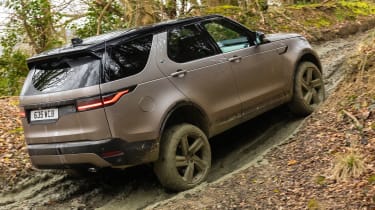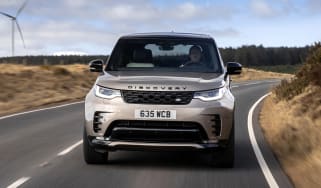Land Rover Discovery review - Engines, drive & performance
"While there’s no escaping the size of the Land Rover Discovery, it’s an impressively relaxing and easy car to drive"
The laws of physics dictate that big, tall cars like the Land Rover Discovery are less agile than smaller, lower cars, and that should inform your expectations – don’t expect it to corner like a hot hatchback, in other words.
That caveat aside, the Discovery is very enjoyable to drive, and changes to the steering and suspension for the facelift have made it more precise. The diesel engine is perfectly paired with the standard eight-speed automatic gearbox, while the air suspension irons out most bumps, even if it became slightly bouncier and less comfy as part of the changes made to the car in 2021. Press on through the corners and you’ll notice a bit of body lean, but the steering is well weighted and accurate, while the air suspension makes the Discovery a cosseting and relaxing car to drive, even with large wheels fitted.
The suspension does a good job of managing the weight of the Discovery, keeping it on an even keel. It’s quiet, too: Land Rover’s engineers say they’ve benchmarked the Discovery against the plusher, pricier and impressively hushed Range Rover; on the basis of our test drive, we believe them, as there’s very little noise from either engine.
More reviews
Naturally, Land Rover has also remained true to the Discovery’s historic reputation for off-road prowess. The latest car takes full advantage of the brand’s Terrain Response system with low-speed off-road cruise control. Allied with sophisticated suspension and high ground clearance, it allows you to wade through up to 900mm of water, or tackle obstructions that would leave many SUV rivals high and dry.
Land Rover Discovery diesel engines
The old four-cylinder and V6 diesel engines have been replaced with an all-new 3.0-litre six-cylinder engine. When not being pushed very hard it remains smooth, and its standard eight-speed automatic gearbox moves between gears almost imperceptibly for quiet, relaxing journeys.
While this engine was originally offered in a range of power outputs, there’s just the D350 version left. This produces 348bhp and can do the 0-62mph sprint in 5.9 seconds, making it more sprightly than the old D250 and D300 models. It has plenty of pulling power, and you can feel the effect of this whenever you hit a steep upward gradient. If you expect to tow, or frequently carry a full load of passengers or cargo, there’s plenty of power in reserve for when you need it.
Petrol engines
The Discovery has been available with a 2.0-litre turbocharged petrol engine badged P300, producing an impressive 296bhp and getting it from 0-62mph in 7.3 seconds as well as the P360 mild-hybrid petrol, which has a 3.0-litre straight-six with 356bhp – these are no longer available, so the only version of the Land Rover Discovery you can currently get brand new is the diesel.













